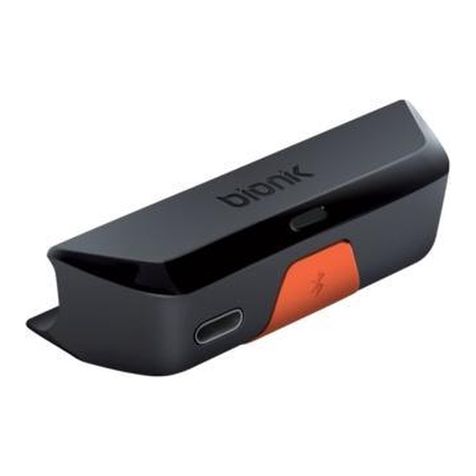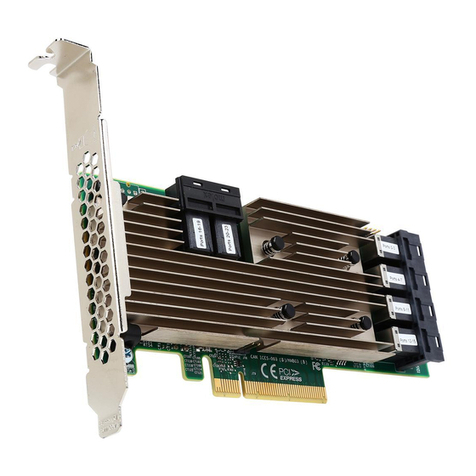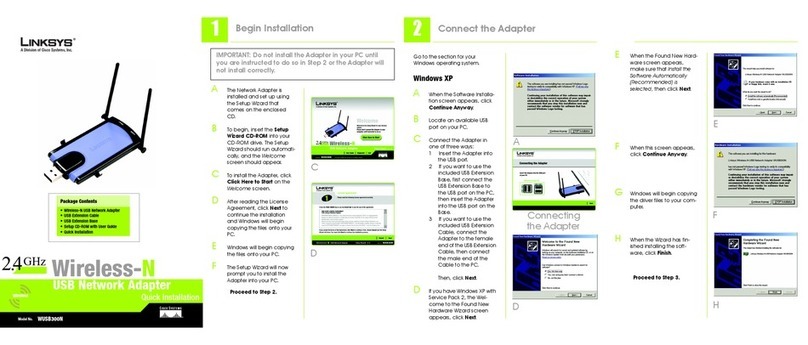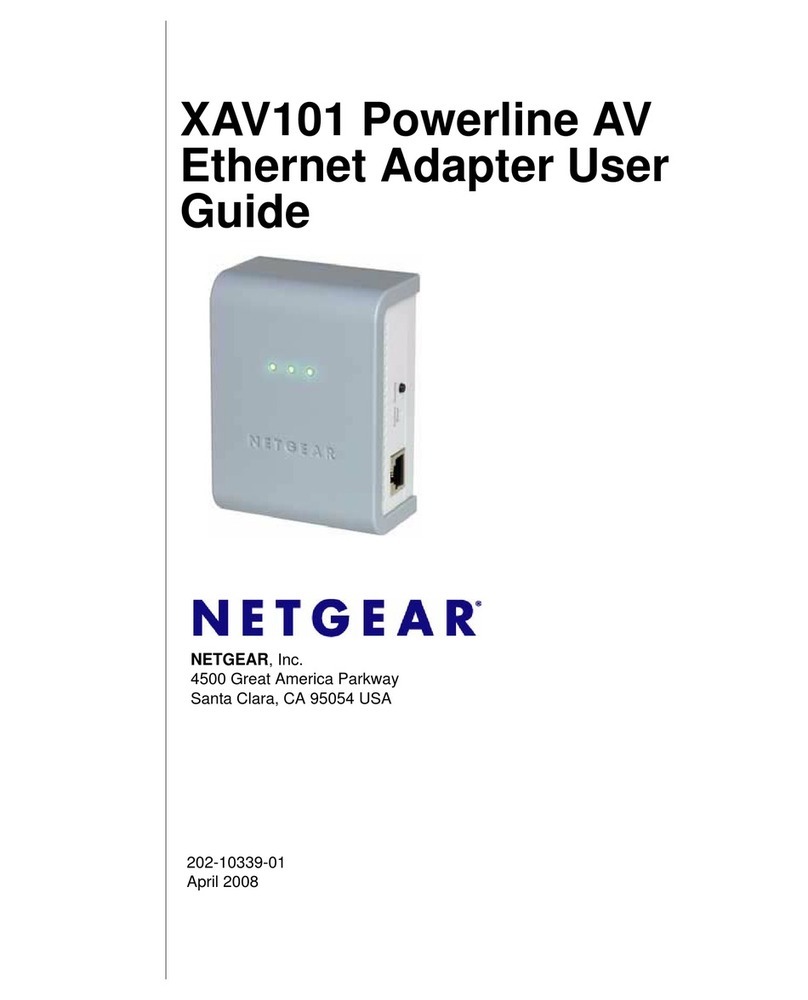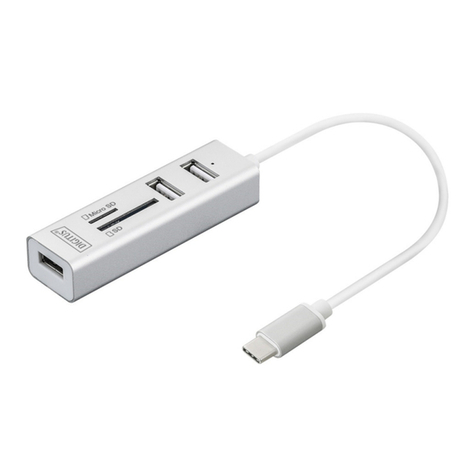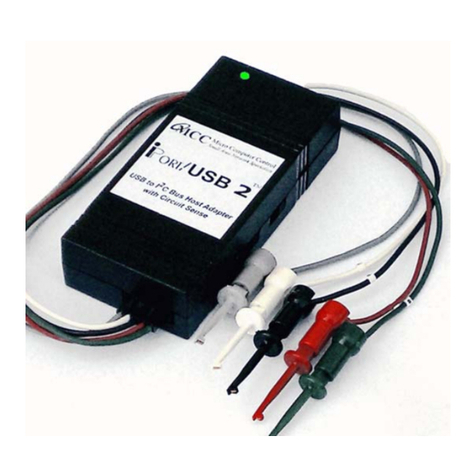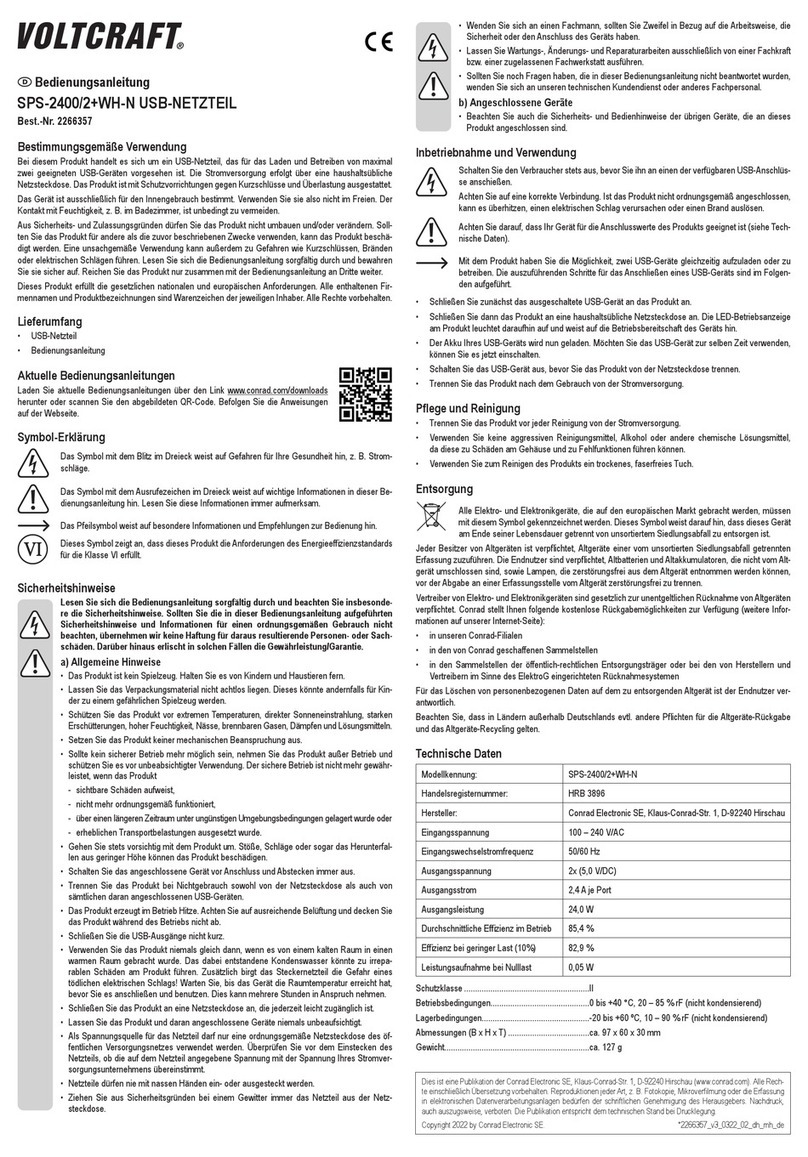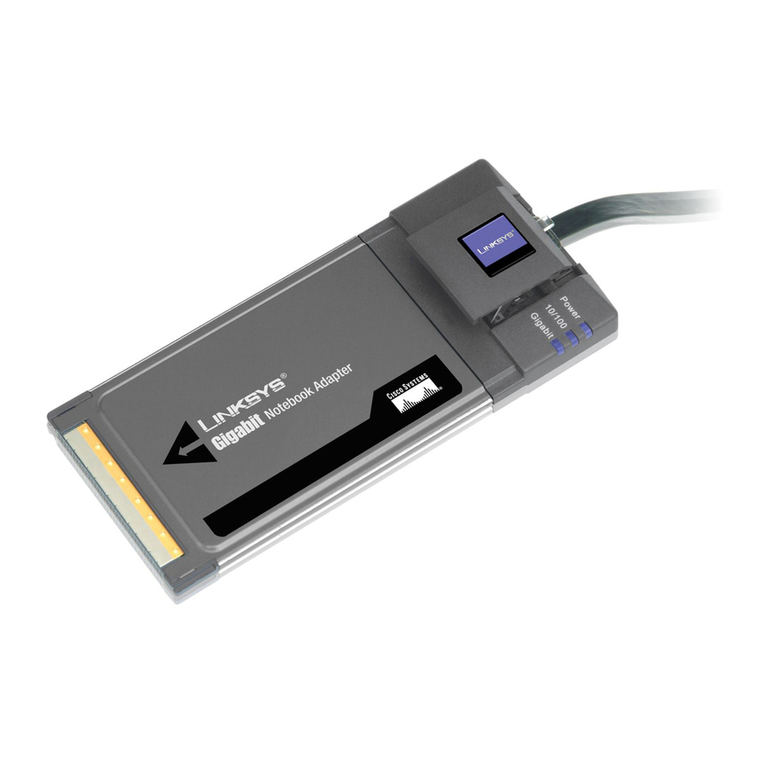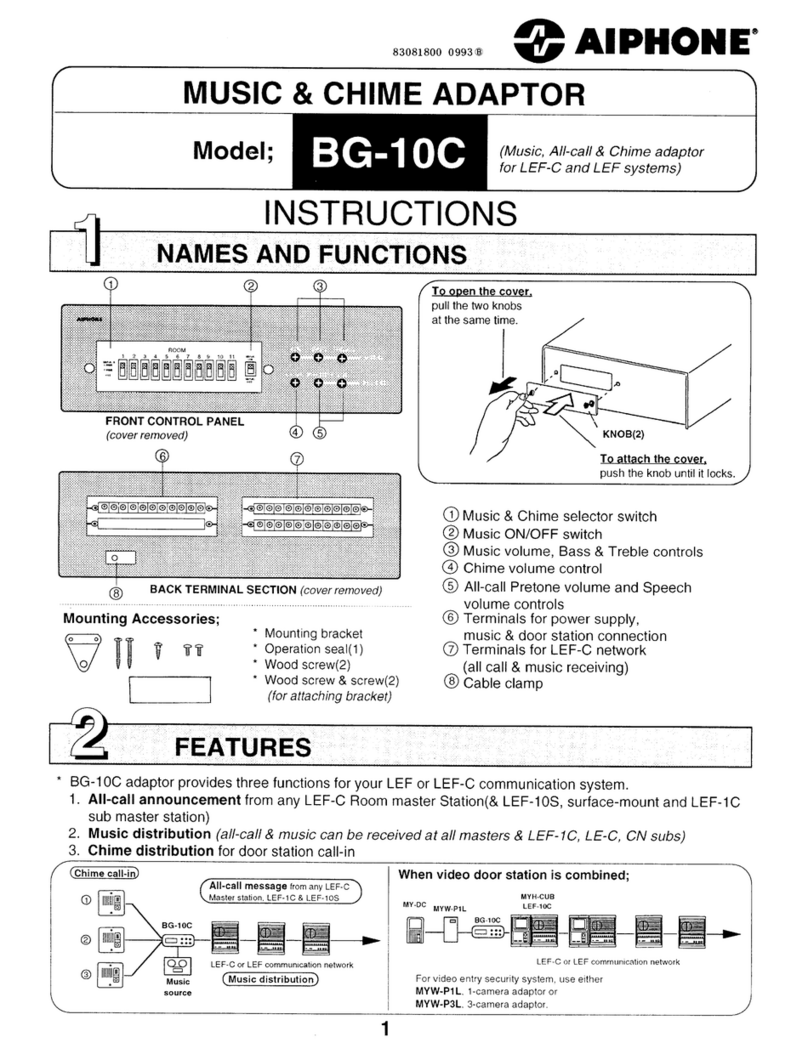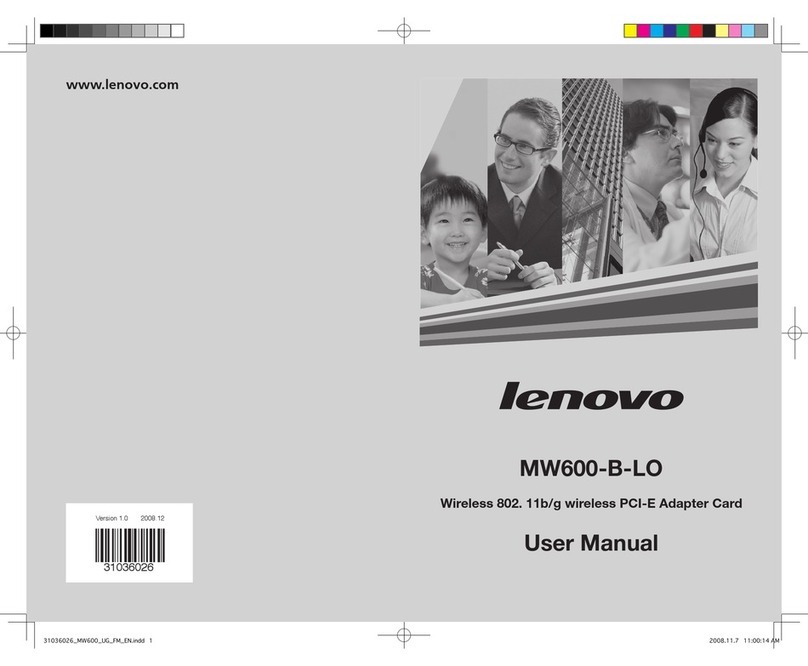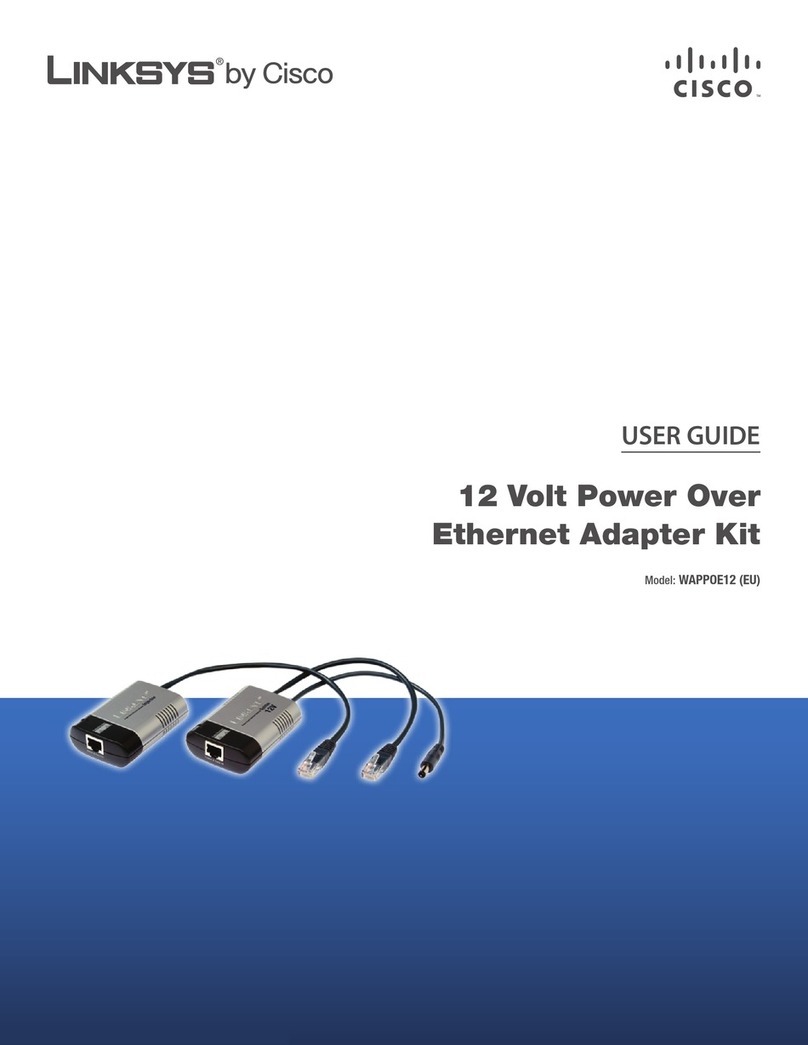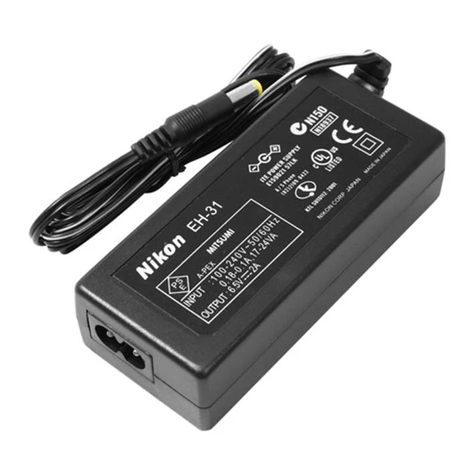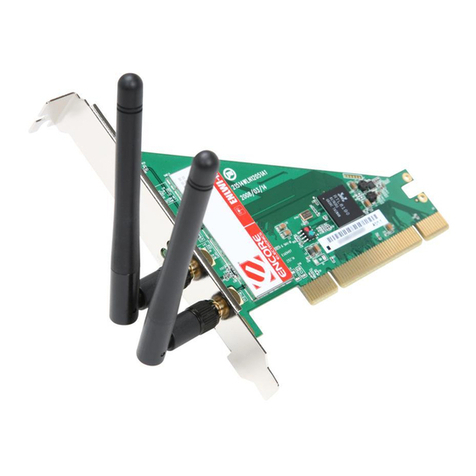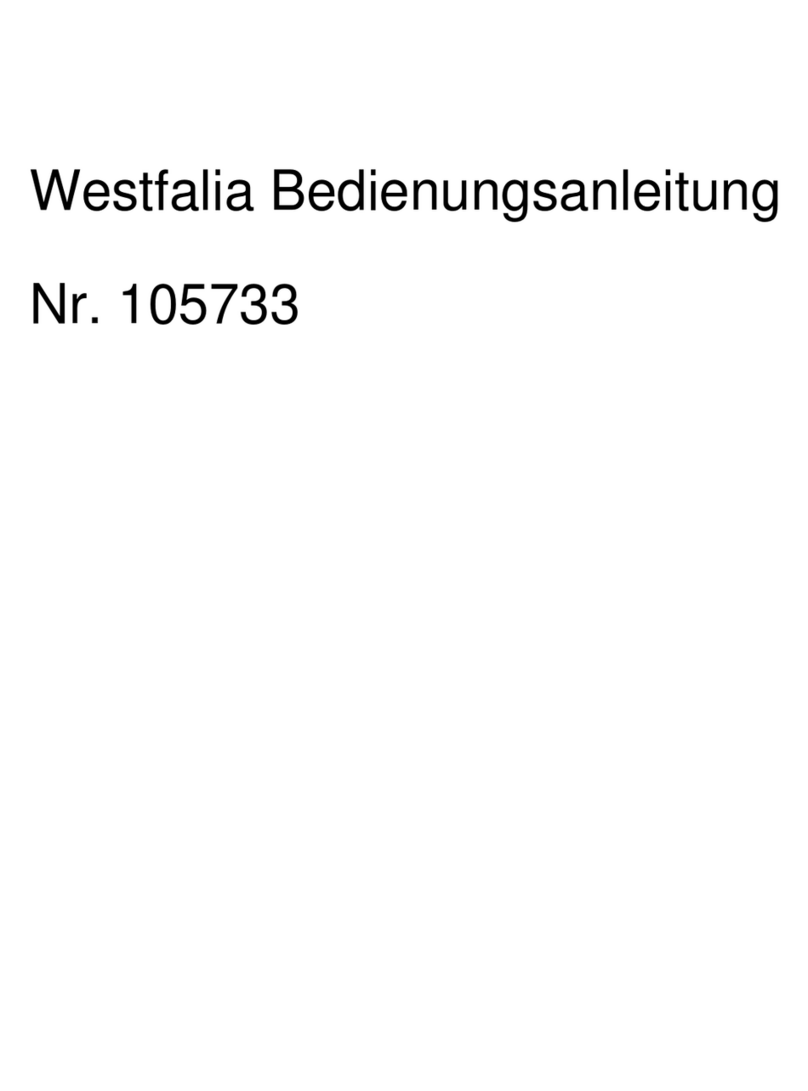YOKOGAWA SA11 User manual

IM 12A06S01-00EN-P
3rd edition
Instruction
Manual
Model SA11
Smart Adapter

IM 12A06S01-00EN-P
2
Introduction
Thank you for purchasing the SA11 Smart Adapter. Please read the following respective
documents before installing and using the SA11. The SA11 Smart Adapter only works with
Yokogawa sensors equipped with an ID-chip. If sensors without ID-chip are connected, all
calculated output data of the SA11 will be disabled.
When the FLXA402 or UM33A-S00 is used as HOST of the SA11 slave device, please refer
to the User’s Manual IM 12A01F01-02 or IM 05P09D21-01EN too.
For the general specifications of the SA11 please refer to the GS 12A06S01-00EN-(P).
The related documents are as follows.
General Specifications
Contents Document number Note
SA11 Smart Adapter GS 12A06S01-00EN-(P) Available for
FLXA402 4-wire Analyzer GS 12A01F01-01EN download
UM33A-S00 Digital Indicator GS 05P03D21-01EN
BA11 Active Junction Box GS 12B06W03-01E-E
Fieldmate GS 01R01A01-01E
IB100 GS 12B06J09-01E-E
WU10/WE10 VP- and Ext. cable GS 12B06W02-02E-E
WU11 Interconnection cable GS 12B06W02-03E-E
User’s Manual
Contents Document number Note
SA11 Smart Adapter
Start-up Manual IM 12A06S01-01Z1-(P) Attached to the product
SA11 Smart Adapter
User’s Manual (English version) IM 12A06S01-00EN-(P) Available for download
SA11 Smart Adapter
User’s Manual (Japanese version) IM 12A06S01-00JA-(P) Available for download
FLXA402 4-wire Analyzer
Start-up Manual IM 12A01F01-01EN Attached to the product
FLXA402 4-wire Analyzer
User’s Manual IM 12A01F01-02EN Available for download
UM33A-S00 Digital Indicator IM 05P09D21-11EN Attached to the product
BA11 Active Junction Box IM 12B06W03-01E-E Attached to the product
WU11 Interconnection cable IM 12B06W02-03E-E Attached to the product
WU10/WE10 VP- and Ext. cable IM 12B06W02-02E-E Attached to the product
Note: The “E” or “EN” in the document number is the language code for English version,
the “JA” indicates the Japanese version and the “Z” indicates it is a multi-language
document.
Downloads can be done from: https://www.yokogawa.
com/solutions/products-platforms/process-analyzers/liquid-
analyzers/#Downloads
You can use the QR-code for quick-access.

IM 12A06S01-00EN-P
3
Notes on Handling User’s Manuals
• Please hand over the user’s manuals to your end users so that they can keep the user’s
manuals on hand for convenient reference.
• Please read the information thoroughly before using the product.
• The purpose of these user’s manuals is not to warrant that the product is well suited to
any purpose but rather to describe the functional details of the product.
• No part of the user’s manuals may be transferred or reproduced without prior written
consent from YOKOGAWA.
• YOKOGAWA reserves the right to make improvements in the user’s manuals and product
at any time, without notice or obligation.
• If you have any questions, or you find mistakes or omissions in the user’s manuals, please
contact our sales representative or your local distributor.
Drawing Conventions
Some drawings may be partially emphasized, simplified, or omitted, for the convenience of
description. Some screen images depicted in the user’s manual may have different display
positions or character types (e.g., the upper / lower case). Also note that some of the
images contained in this user’s manual are display examples.
Composition of this User’s Manual
Contents pH/ORP Specific Conductivity
Introduction and general description Section 1
Wiring and installation Section 2
Operation Section 3 Section 6
Commissioning Section 4 Section 7
Calibration Section 5 Section 8
Maintenance Section 9
Troubleshooting Section 10
Appendices Section 11

IM 12A06S01-00EN-P
4
Safety Precautions
Safety, Protection, and Modification of the Product
• In order to protect the system controlled by the product and the product itself and ensure
safe operation, observe the safety precautions described in this user’s manual. We
assume no liability for safety if users fail to observe these instructions when operating the
product.
• If this instrument is used in a manner not specified in this user’s manual, the protection
provided by this instrument may be impaired.
• If any protection or safety circuit is required for the system controlled by the product or for
the product itself, prepares it separately.
• Be sure to use the spare parts approved by Yokogawa Process Analyzers (simply referred
to as YOKOGAWA) when replacing parts or consumables.
• Modification of the product is strictly prohibited.
• The following safety symbols are used on the product as well as in this manual.
WARNING
This symbol indicates that an operator must follow the instructions laid out in this manual
to avoid the risks, for the human body, of injury, electric shock, or fatalities. The manual
describes what special care the operator must take to avoid such risks.
CAUTION
This symbol indicates that the operator must refer to the instructions in this manual
to prevent the instrument (hardware) or software from being damaged, or a system
failure from occurring.
CAUTION
This symbol gives information essential for understanding the operations and functions.
NOTE
This symbol indicates information that complements the present topic.
This symbol indicates Protective Ground Terminal.
This symbol indicates Function Ground Terminal. Do not use this terminal as the protective
ground terminal.

IM 12A06S01-00EN-P
5
Warning and Disclaimer
The product is provided on an “as is” basis. YOKOGAWA shall have neither liability nor
responsibility to any person or entity with respect to any direct or indirect loss or damage
arising from using the product or any defect of the product that YOKOGAWA cannot predict
in advance.
SA11
• The SA11 should only be used with equipment that meets the relevant IEC, American,
Canadian, and Japanese standards. Yokogawa accepts no responsibility for the misuse of
this unit.
• The Instrument is packed carefully with shock absorbing materials, nevertheless, the
instrument may be damaged or broken if subjected to strong shock, such as if the
instrument is dropped. Handle with care.
CAUTION
Electrostatic discharge
The SA11 contains devices that can be damaged by electrostatic discharge.
When servicing this equipment, please observe proper procedures to prevent such damage.
CAUTION
Do not use an abrasive or organic solvent in cleaning the instrument.
CAUTION
This device is an EN61326-1 Class A product, and it is designed for use in the industrial
environment. The device however can be used in a laboratory environment too.
CAUTION
Be careful to touch the concentrated sulfuric acid.

IM 12A06S01-00EN-P
6
Product Disposal
The instrument should be disposed of in accordance with local and national legislation/
regulations.
Warranty and service
Yokogawa products and parts are guaranteed free from defects in workmanship and
material under normal use and service for a period of (typically) 12 months from the date of
shipment from the manufacturer.
Individual sales organizations can deviate from the typical warranty period, and the
conditions of sale relating to the original purchase order should be consulted. Damage
caused by wear and tear, inadequate maintenance, corrosion, or by the effects of chemical
processes are excluded from this warranty coverage.
In the event of warranty claim, the defective goods should be sent (freight paid) to the
service department of the relevant sales organization for replacement (at Yokogawa
discretion).
The following information must be included in the letter accompanying the returned goods:
• Part number, model code and serial number
• Original purchase order and date
• Length of time in service and a description of the process
• Description of the fault, and the circumstances of failure
• Process/environmental conditions that may be related to the failure of the device.
• A statement whether warranty or non-warranty service is requested
• Complete shipping and billing instructions for return of material, plus the name and phone
number of a contact person who can be reached for further information.
Returned goods that have been in contact with process fluids must be decontaminated /
disinfected before shipment. Goods should carry a certificate to this effect, for the health
and safety of our employees.
Material safety data sheets should also be included for all components of the processes to
which the equipment has been exposed.
Copyright and Trademark Notices
The online manual is protected by the PDF security from modification, however, it can be
output via a printer. Printing out the online manual is only allowed for using the product.
When using the printed information of the online manual, check if the version is the most
recent one by referring to the version attached to the product.
No part of the online manual may be transferred, sold, distributed (including delivery via a
commercial PC network or the like), or registered or recorded on video tapes.
FLEXA, FLXA, SENCOM and FieldMate are trademarks or registered trademarks of
Yokogawa Electric Corporation.
Adobe, Acrobat and Acrobat Reader are either registered trademarks or trademarks of
Adobe Systems Incorporated in the United States and/or other countries.
All other company and product names mentioned in this user’s manual are trademarks or
registered trademarks of their respective companies.
We do not use TM or ® mark to indicate those trademarks or registered trademarks in this
user’s manual.

IM 12A06S01-00EN-P
7
SA11 fonts
(c) Copyright 2000-2001 /efont/ The Electronic Font Open Laboratory. All rights reserved.
Redistribution and use in source and binary forms, with or without modification, are
permitted provided that the following conditions are met:
1. Redistributions of source code must retain the above copyright notice, this list of
conditions and the following disclaimer.
2. Redistributions in binary form must reproduce the above copyright notice, this list of
conditions and the following disclaimer in the documentation and/or other materials
provided with the distribution.
3. Neither the name of the team nor the names of its contributors may be used to endorse
or promote products derived from this font without specific prior written permission.
THIS FONT IS PROVIDED BY THE TEAM AND CONTRIBUTORS “AS IS” AND ANY
EXPRESS OR IMPLIED WARRANTIES, INCLUDING, BUT NOT LIMITED TO, THE
IMPLIED WARRANTIES OF MERCHANTABILITY AND FITNESS FOR A PARTICULAR
PURPOSE ARE DISCLAIMED. IN NO EVENT SHALL THE TEAM OR CONTRIBUTORS
BE LIABLE FOR ANY DIRECT, INDIRECT, INCIDENTAL, SPECIAL, EXEMPLARY, OR
CONSEQUENTIAL DAMAGES (INCLUDING, BUT NOT LIMITED TO, PROCUREMENT OF
SUBSTITUTE GOODS OR SERVICES; LOSS OF USE, DATA, OR PROFITS; OR BUSINESS
INTERRUPTION) HOWEVER CAUSED AND ON ANY THEORY OF LIABILITY, WHETHER IN
CONTRACT, STRICT LIABILITY, OR TORT (INCLUDING NEGLIGENCE OR OTHERWISE)
ARISING IN ANY WAY OUT OF THE USE OF THIS FONT, EVEN IF ADVISED OF THE
POSSIBILITY OF SUCH DAMAGE.
CE marking products
Authorized Representative in EEA
The Authorized Representative for this product in EEA is Yokogawa Europe B.V.,
Euroweg 2, 3825 HD Amersfoort, The Netherlands.
Identification Tag
This manual and the identification tag attached on a packing box are essential parts of the
product. Keep them together in a safe place for future reference.
Users
This product is designed to be used by a person with specialized knowledge.

IM 12A06S01-00EN-P
8
Contents
Introduction 2
General Specifications 2
User’s Manual 2
Safety Precautions 4
Warning and Disclaimer 5
Product Disposal 6
Warranty and service 6
Copyright and Trademark Notices 6
CE marking products 7
1 INTRODUCTION AND GENERAL DESCRIPTION 11
1.1. Instrument check 11
1.2. Checking the accessories 12
1.3. Regulatory Compliance 12
1.4. Model & Suffix Codes 13
1.5. Spare part list 13
2 WIRING AND INSTALLATION 14
2.1 Installation site 14
2.2 Connecting to the sensor 14
2.2.1 Direct mounting 14
2.2.2 Cable mounting 15
2.3 Wiring to the HOST system 15
2.3.1 Wired connection 15
2.3.2 Connection in daisy chain concept 15
2.3.3 Wireless connection 16
2.3.4 Grounding 16
2.4 Operation 17
3 OPERATION OF pH/ORP 17
3.1 SA11 quick setup 17
3.2 Measurement setup 17
3.2.1 Parameter setting 17
3.2.2 Temperature setting 17
3.3 pH/ORP zero, slope and impedance 17
3.3.1 Zero 17
3.3.2 Slope 18
3.3.3 Impedance 18
3.4 Diagnostics 19
3.4.1 Liquid Earth (LE) detection 19
3.4.2 Device state 19
3.4.3 Calibration due 19
3.4.4 Last calibrated 19
3.4.5 Predictive maintenance 19
3.4.6 Sensor wellness 20
3.4.7 Sensor status 20
3.5 Output setup 21
3.6 Calibration and Commissioning 21

IM 12A06S01-00EN-P
9
4 COMMISSIONING OF pH/ORP 22
4.1 Measurement setup 22
4.1.1 Measurement select 22
4.1.2 Temperature settings 22
4.1.3 Temperature compensation 22
4.1.4 Process compensation 23
4.1.5 pH settings 23
4.1.6 ORP settings 24
4.1.7 rH settings 24
4.1.8 Impedance settings 24
4.1.9 Unit conversion 24
4.1.10 Calibration settings for pH/ORP1/ORP2 24
4.2 Communication setup 25
4.3 Error configuration 25
4.4 Logbook configuration 28
5 CALIBRATION OF pH/ORP 29
5.1 Temperature calibration 29
5.2 pH calibration 29
5.2.1 Manual calibration 29
5.2.2 Automatic calibration 30
5.2.3 Sample calibration 30
5.2.4 Fully Automatic calibration 31
5.3 ORP/rH calibration 31
6 OPERATION OF SC (Specific Conductivity) 32
6.1 SA11 quick setup 32
6.2 Measurement setup 32
6.2.1 Parameter setting 32
6.2.2 Temperature setting 32
6.3 Cell constant & polarization 32
6.3.1 Cell constant 32
6.3.2 Polarization 32
6.4 Diagnostics 32
6.4.1 Device state 32
6.4.2 Calibration due 33
6.4.3 Last calibrated 33
6.4.4 Predictive maintenance 33
6.4.5 Sensor wellness 33
6.4.6 Sensor status 34
6.5 Output setup 34
6.6 Calibration and Commissioning 34

IM 12A06S01-00EN-P
10
7 COMMISSIONING OF SC (Specific Conductivity) 35
7.1 Measurement setup 35
7.1.1 Measurement select 35
7.1.2 Temperature settings 35
7.1.3 Temperature compensation 35
7.1.4 Process compensation 35
7.1.5 Concentration 36
7.1.6 USP23 36
7.1.7 SC settings 36
7.1.8 Unit conversion 37
7.1.9 Calibration settings for Conductivity/Resistivity 37
7.2 Communication setup 37
7.3 Error configuration 38
7.4 Logbook configuration 39
8 CALIBRATION OF SC (Specific Conductivity) 40
8.1 Temperature calibration 40
8.2 Cell constant calibration 40
8.2.1 Cell constant (manual) 40
8.2.2 Cell constant (automatic) 40
8.2.3 Sample 41
8.3 Temperature coefficient (TC) 41
9 MAINTENANCE 42
9.1 Periodic maintenance SA11 42
9.2 Periodic maintenance of sensors 42
10 TROUBLESHOOTING 43
10.1 Installation of SA11 43
10.2 Setting of the SA11 43
10.3 Sensor 43
10.4 Application 43
11 APPENDICES 44
11.1 Appendix 1: Factory defaults & setting limits pH 44
11.2 Appendix 2: Buffer tables and matrix compensation pH 46
11.3 Appendix 3: Logbook pH 48
11.4 Appendix 4: Factory defaults & setting limits SC 49
11.5 Appendix 5: Matrix tables and buffer solutions SC 50
11.6 Appendix 6: USP <645> 54
11.7 Appendix 7: Logbook SC 55

IM 12A06S01-00EN-P
11
1 INTRODUCTION AND GENERAL DESCRIPTION
This manual describes how to use SA11 with Yokogawa’s HOST systems and sensors.
Please read carefully this manual and the instruction manual of the relevant HOST system
and sensor before using this SA11 slave device.
The model SA11 Smart Adapter can perform 2 kind of measurements, each measurement
having it’s own specific SA11 model of wich the pH parameter is devided into a model for
conventional pH sensors and a model for differential pH sensors:
1a. pH/ORP (oxidation-reduction potential) for conventional sensors, model SA11-P1;
1b. pH/ORP (oxidation-reduction potential) for differential sensors, model SA11-P2;
2. Contact Conductivity (SC), model SA11-C1.
1.1.Instrument check
Upon delivery, unpack the device carefully and inspect it to ensure that it was not damaged
during shipment. If damage is found, retain the original packing materials (including the outer
box) and then immediately notify the carrier and the relevant Yokogawa sales office.
• Checking the model and suffix code
Make sure the model and suffix code on the metallized label affixed to the device housing
are in line with the order. Refer to Section 1.4.
Note: Be sure to apply correct power to the device, as detailed on the label.
CAUTION
The device is packed carefully in a shock absorbing box, nevertheless, the device may be
damaged or broken if subjected to strong shock, such as if the box is dropped. Handle with
care.
• Checking the serial number
The Serial Number is defined by nine (9) alphanumeric characters as follows:
X1X2Y3M4N5N6N7N8N9e.g. N3U100021
X1X2: Production Site
Y3M4: Year/Month code
N5N6N7N8N9: Tracking number
Table 1.1: Production year code
Year Year code Year Year code Year Year code Year Year code
2010 K 2015 R 2020 W 2025 2
2011 L 2016 S 2021 X 2026 3
2012 M 2017 T 2022 Y 2027 4
2013 N 2018 U 2023 Z 2028 5
2014 P 2019 V 2024 1 2029 6
Table 1.2: Production month code
Month Month code Month Month code Month Month code
January 1 May 5 September 9
February 2 June 6 October A
March 3 July 7 November B
April 4 August 8 December C

IM 12A06S01-00EN-P
12
Figure 1.1: Example of label SA11
1.2.Checking the accessories
Make sure that besides the SA11 device the accessories in Table 1.3 are included. Options
are available only if ordered.
Table 1.3: Accessories
Product Name Quantity Remark
SA11 Smart Adapter dust caps 2 pcs/device To prevent dust inside the connectors
Option: Universal mounting set 1 set Option code /UM*
Startup Manual 1 copy Quick startup description
QIS/QIC 1 copy Test certificate
* Option /UM contains Pipe and Wall mounting hardware
Note: Be sure to remove the dust caps before using the device.
1.3.Regulatory Compliance
Safety: IEC 61010-1
EN61010-1
Category based on IEC 61010: I (Note 1)
Pollution degree based on IEC 61010: 2 (Note 2)
Note 1: Installation category, called over-voltage category, specifies impulse withstand
voltage. Equipment with “Category I” is used for connection to circuits in which
measures are taken to limit transient over-voltages to an appropriately low level.
Note 2: Pollution degree indicates the degree of existence of solid, liquid, gas or other
inclusions which may reduce dielectric strength.
EMC: EN61326-1 Class A, Table 2 (For use in industrial locations)
Influence of immunity environment (Criteria A): Output is within
accuracy
EN61326-2-3
AS/NZS CISPR11
KC (registered as R-R-YPA-SA11)
RoHS2: EN 50581
Installation altitude: 2000 m or less

IM 12A06S01-00EN-P
13
CAUTION
The device is packed carefully in a shock absorbing box, nevertheless, the device may be
damaged or broken if subjected to strong shock, such as if the box is dropped. Handle with
care.
CAUTION
The device is a Class A product, and it is designed for use in the industrial environment.
The device however can be used in a laboratory environment too.
WARNING
Do not use an abrasive or organic solvent in cleaning the device.
WARNING
The SA11 contains components that can be damaged by electrostatic discharge.
When servicing this device, please observe proper procedures to prevent such damage.
1.4.Model & Suffix Codes
Model Suffix code Option code Description
SA11 SENCOM Smart Adapter
Measuring -P1 pH/ORP, conventional
Parameter -P2 pH/ORP, differential
-C1 Specific Conductivity
Type -AA General purpose
Region -N Not specified
Conn. type -VS Variopin connector for SENCOM ID-chip
in sensor
Style -NN Always -NN
Option /UM Pipe and wall mounting hardware
1.5.Spare part list
Order no. Product Name Quantity Remark
K1548PQ Universal mounting set 1 set Option /UM
K1548GF O-ring set (5 pieces) 1 set
Option /UM contains Pipe and Wall mounting hardware
Figure 1.2: Positioning of O-ring

IM 12A06S01-00EN-P
14
2 WIRING AND INSTALLATION
Figure 2.1: Installation diagram SA11
2.1 Installation site
The SA11 is weatherproof and can be installed both inside and outside. Select an
installation site that meets the following conditions:
• Mechanical vibrations and shocks are negligible
• No relay switch and power switch are installed close to the device
• There is space mounting the device to the Yokogawa sensor & Yokogawa HOST system
• Not exposed to direct sunlight or severe weather conditions
• Maintenance is possible
• No corrosive atmosphere
• Water Protection: IP67, NEMA Type 4X
2.2 Connecting to the sensor
2.2.1 Direct mounting
The SA11 can be installed directly on top of the Yokogawa labelled sensor by means of the
Variopin connection system. In this case the temperature limit of the device is determined by
the process temperature, limited from -30 up to +100°C / -22 up to +212°F for power supply
+2.7 to +4.5VDC, -30 up to +125°C / -22 up to +257°F for power supply +4.5 to +5.5VDC.
Figure 2.2: Example of direct mounting of SA11 to sensor
CAUTION
Place the Variopin connectors securely to guarantee IP67.
YPA Europe
Made in the Netherlands 3825HD-2
BA11
ACTIVE JUNCTION BOX
BUS SENSOR CONNECTIONS
IN OUT J1 J2 J3 J4
WU11-M9-**-CN-S
Modbus Host
e.g. FLXA402
WU11-M9-**-WP-S
WU11-M9-**-WP-S
max. 100m (328ft)
max. 100m
(328ft)
max. 100m
(328ft)
Suffix -C-AA-M9
Serial# N3T400171
Power +2.7. +5.5VDC/30mW
T amb. -20.. + 55ºC
IP Type 4X / IP66 2018
Read IM
12B06W03-01E-E

IM 12A06S01-00EN-P
15
2.2.2 Cable mounting
When there is less room to install the SA11 on top of the Yokogawa labelled sensor or
when the process conditions are higher than +100°C (for power supply +2.7 to +4.5VDC) or
+125ºC (for power supply +4.5 to +5.5VDC), an alternative mounting method is to install the
SA11 using the optional wall/pipe mounting hardware. The SA11 in this case is connected
to the sensor using the dedicated extension cable model WE10 with a fixed length of 2.95
meter. The ambient temperature limit of the device has to be within -30 to +55°C.
Figure 2.3: Example of cable mounting of SA11 to sensor
CAUTION
Place the Variopin connectors securely to guarantee IP67. When securing the Variopin
connectors, be sure no moisture is encaptulated to garantee isolation in between the
individual contacts. Variopin connector can be cleaned with iso-propanol. Be sure it is dry
before re-connecting.
Note: Use the correct Variopin cable. For correct measurement without loss of specification
the SA11-P1 must be used with WE10-H-D-003-V1, all other types must be used
with WE10-H-D-003-V2.
2.3 Wiring to the HOST system
2.3.1 Wired connection
The Yokogawa HOST system is connected to the SA11 using the WU11 type S
interconnection cable with at one end wired terminals and on the other end a M9 connector.
This cable is specified for reliable transfer of digital signals, and especially designed to
be installed in a heavy industrial environment. The double shielded cable will protect the
connected devices for interference from high voltages and currents which are present
on other cables. The cable is specified to be used in IP67 applications, allowing it to be
submerged as a whole. The WU11 type S cable is available length up to a maximum of 100
meter.
2.3.2 Connection in daisy chain concept
The Yokogawa HOST system model FLXA402 can be connected to maximum five (5) SA11
devices. In case of more than two (2) SA11 devices connected, the BA11 Active Junction
Box must be used. Connection in between the FLXA402 and BA11 is done by using the
WU11 type S interconnection cable with at one end wired terminals and on the other end
a M9 connector. Connection in between the BA11 and the SA11 is done using the WU11
type S interconnection cable with at both ends a M9 connector. In both cases the maximum
length has to be within 100 meter.

IM 12A06S01-00EN-P
16
2.3.3 Wireless connection
In laboratory environments the HOST Fieldmate system can be connected to the SA11
using the Yokogawa Bluetooth device model IB100. Interconnection in between the IB100
and SA11 is done using the WU11 type S interconnection cable with at both ends a M9
connector. The wireless communication in between the Fieldmate system and IB100 is
limited to a distance of 10 meter.
Grounding
The measuring system must always be
connected to a class D ground (a ground
resistance of 100 Ohm or less), preferably
done at the HOST side. To protect the
SA11 device against interference, such as
electromagnetic noise or common mode, all
wires in WU11 type -S cable are connected
at HOST. This makes the housing of the
SA11 grounded. For correct measurement
without loss of specifications, it is strongly
recommended to ensure that the process
liquid is grounded. Figure 2.4 shows the
connection diagram in case without/UM
option.
However, in case that there is different
potential between Ground at HOST side and
Ground which the housing of the SA11 is
connected, figure 2.5 shows the example
of the installation. To prevent ground loop
by this different potentials it is necessary to
disconnect one of the ground references.
This can be done at the HOST side by
disconnecting the wire #82 of the WU11 type
S cable. Please connect #82 to NC terminal
on the SENCOM SA module when SA11 is
connected to FLXA402. Please be sure to
insulate contact pin of #82 wire from terminals
and metal housing, when SA11 is connected
to other host. The SA11 device must then
be installed using the optional pipe and wall
mounting hardware (/UM) with a ground wire
connected in between the ground terminal
of the mounting bracket and the ground
reference of the process.
Alternate way to prevent ground loop is
to isolate the SA11 & mounting plate from
ground 2 & keep the terminal 82 connected.
Remark: For the installation shown in Figure
2.5, in case the ground references at the
HOST side (Ground 1) and process side
(Ground 2) have no potential difference the
Host
WU11
(max 10m)
Ground
WE10
(max 3m)
SA11/UM
Sensor
Liquid
IB100
Figure 2.6: Installation example
SA11 & IB100 to prevent interference
Ground 1
#82
Host
WU11
(max 100m)
Ground 2
WE10
(max 3m)
SA11/UM
Sensor
Liquid
Figure 2.5: Typical installation example
to prevent ground loop
Host
Ground 1
Sensor
SA11
WU11
(max 100m)
Liquid
Ground 2
Figure 2.4: Typical installation of
SA11 to host

IM 12A06S01-00EN-P
17
shield wire of the WU11 type -S cable (wire #82) can stay connected to the (pre-defined)
ground terminal at the HOST.
In combination with Host who does not have grouding terminal to still meet the statutory
regulations it is necessary to ground either the SA11 enclosure (e.g. by using the option /
UM) or ground the shield of the cable. An example is shown in figure 2.6.
Operation
Select a YOKOGAWA parameter specific sensor equipped with an ID-chip which is suitable
for the process. When all wiring is completed, turn on the power of the HOST system. Part
of the setup of the SA11 will be done automatically by reading the content of the ID-chip of
the sensor. These are sensor characteristics, factory calibration data, customer calibration
data, diagnostics and loggings of calibration and events. For details refer to the SA11 Smart
Adapter User’s Manual. Other setups have to be done by the YOKOGAWA HOST system,
for details see the belonging User’s Manual. If the system is configured incorrectly, an error
indicator may be displayed, or the measurement values displayed may be incorrect. Refer to
the User Manual of the HOST system how to check the initial settings and change them to
suit your purpose.
3 OPERATION OF pH/ORP
3.1 SA11 quick setup
Select a Yokogawa pH/ORP electrode equipped with an ID-chip which is suitable for the
process. When connected to the SA11 and powered, part of the setup of the SA11 will be
done automatically by reading the content of the ID-chip of the sensor. These are sensor
characteristics, factory calibration data, customer calibration data, diagnostics and loggings
of calibration and events. See section 4 and 5 for details.
Other setups have to be done by the Yokogawa HOST system, for details see the belonging
User’s Manual.
3.2 Measurement setup
3.2.1 Parameter setting
The SA11 measures and calculates process parameters, for details see section 4.
The suitable measurement parameter(s) for display and process control can be set by the
Yokogawa HOST system, for details see the belonging User’s Manual.
3.2.2 Temperature setting
The SA11 measures process temperature in Celsius (ºC) or Fahrenheit (ºF). Setup of the
temperature unit is done by the Yokogawa HOST system, for details see the belonging
User’s Manual.
3.3 pH/ORP zero, slope and impedance
3.3.1 Zero
The ZERO is the calibrated sensor offset in mV. Theoretically, the sensor reads 0 mV in a
buffer solution of pH7. The ZERO value indicates the condition of the sensor. The trend of
ZERO drift of the sensor is used to predict the lifetime of the sensor.
ZERO can also be displayed in pH units and then it represents the pH value where the
sensor output is 0 mV at 25ºC. Settings can be done with the Yokogawa HOST system, for
details see the belonging User’s Manual.

IM 12A06S01-00EN-P
18
3.3.2 Slope
The SLOPE is the calibrated efficiency of the sensor unit as a percentage of the theoretical
slope of the sensor unit. The theoretical slope follows the NERNST equation and is
59.16 mV/pH (at 25ºC). The SLOPE can be calibrated only after a two- or a three point
calibration in buffer solutions with a different pH value. A low slope indicates that the sensor
is not clean or is faulty.
The SLOPE can also be displayed as mV/pH at 25ºC. Settings can be done with the
Yokogawa HOST system, for details see the belonging User’s Manual.
Figure 3.1: Zero/slope example
3.3.3 Impedance
The SA11 can measure the condition of the electrodes connected. This is done by
measuring the electrical resistance, and this can be either high-ohmic or low-ohmic.
If the impedance measurement is set as high-ohmic, the measurement is used for glass
break detection. The detection limit is set automatically by the sensor characteristics.
In case the impedance measurement is set as low-ohmic, the measurement is used for
fouling and dry fall detection. Detection limits to be set by Yokogawa HOST system.
The SA11 impedance measurement depends on the device type and connected sensor.
• SA11-P1 type in combination with a pH sensor with Liquid Earth (LE) element:
The SA11 measures both the electrical resistance of the high-ohmic glass membrane
electrode and the electrical resistance of the low-ohmic reference electrode liquid
junction. The liquid junction forms the electrolytic contact between the liquid earth and the
reference electrode. It must be kept clean and filled with conductive electrolyte otherwise
the measurement will suffer from instability, drift and measuring errors.
• SA11-P1 type in combination with a pH sensor without Liquid Earth element:
The SA11 measures only the electrical resistance of the high-ohmic glass membrane
electrode.
• SA11-P2 type in combination with a pH sensor with Liquid Earth element:
The SA11 measures the electrical resistance of the two high-ohmic glass membrane
electrodes.
In cases where a Liquid Earth is suitable for ORP measurement, the impedance value
is based upon the electrical resistance of the low-ohmic reference. For an ORP-pH
compensated measurement the impedance value is based upon the electrical resistance of
the (high-ohmic) glass membrane reference.
pH14
pH0
pH7, 0mV
Theoretical value
+mV
-mV Calibration curve (slope)
Zero
F0410.ai

IM 12A06S01-00EN-P
19
3.4 Diagnostics
3.4.1 Liquid Earth (LE) detection
If a Yokogawa sensor with ID-chip is connected to a SA11-P1 type, the sensor
characteristics explains if LE element is available or not. If available, the SA11 will activate
the LE detection. If LE wiring is broken, an error will be flagged. If a Yokogawa sensor
with ID-chip is connected to a SA11-P2 type, the LE element is always available. The LE
detection is active and if LE wiring is broken an error will be flagged.
3.4.2 Device state
The operating mode of the SA11 is reflecting the device state. Except from the standard
operating mode there are four other modes:
• Sleep mode (all calculations disabled)
• Calibration
• HOLD
• Safely remove (this is not a function of Yokogawa HOST systems)
3.4.3 Calibration due
Calibration due is the date when the calibration must be done next according to the settings
of the calibration interval. The calibration intervals are set by the Yokogawa HOST system,
for details see the belonging User’s Manual.
3.4.4 Last calibrated
The last calibrated is the date on which the last sensor calibration was performed. For ZERO
the displayed value is date of this last calibration. For SLOPE the displayed value is the date
that the last 2-point calibration is executed.
3.4.5 Predictive maintenance
There are two kinds of predictive maintenance:
• Predictive sensor maintenance, which predicts the date when the sensor will need
recalibrating for maintaining measurement accuracy. The function checks the low-ohmic
reference impedance every 24 hours. The function predicts the date when the reference
impedance will cross the upper or lower limits set by the Yokogawa HOST system, and
indicates the date and its reliability status. The date is predicted based on the intersection
point of the upper or lower limits and the extrapolated line of the values obtained by the
least squares method.
Figure 3.2: Predictive sensor maintenance date
Day
Value Lower limit
Upper limit
Current
date
Projected
maintenance date F0310.ai

IM 12A06S01-00EN-P
20
• Predictive sensor replacement, which predicts the date when the sensor will need
replacement. The date is based on the pH ZERO and pH SLOPE on each calibration, and
the measured low-ohmic reference impedance. The date is predicted based on the best
status of correlation in those three parameters. If some parameters have the same status,
the nearest date is selected. The function indicates the date and its reliability status.
3.4.6 Sensor wellness
The SA11 can calculate the performance status of the sensor connected. The calculated
result depends on user programmable settings done in the Yokogawa HOST system, and
the sensor diagnostics data stored in the ID-chip of the sensor.
When a sensor is replaced or exchanged, a reset of the wellness data is not necessary. If a
user wants to reset this data anyhow, this is possible by the Yokogawa HOST system. For
details see the belonging User’s Manual.
There are seven (7) different wellness statuses for pH:
• ZERO
• SLOPE
• IMP1
• IMP2
• Progress time
This is the time in between 0 and actual operating hours of the sensor.
• Heat cycle
This is a counter which counts the settable temperature step changes (up or down) of a
sensor.
• Total
This state indicates the worst wellness state of those activated.
Each wellness status can be set ON or OFF. If activated, the status is measured as a ratio of
the actual value against the calculated value obtained from settings of lower limit and upper
limit. For limit setting see Appendix 1. The status is indicated as a number in between 0
(bad) and 4 (good).
3.4.7 Sensor status
The SA11 monitors some process conditions of the connected sensor:
•Maximum temperature exposed, which is automatically updated every time a higher
process temperature is measured.
• High temperature 1/High temperature 2, which is the total time at which the sensor
is exposed above the corresponding limits, set by the Yokogawa HOST system. The last
date and time (the end of high-temperature condition) is stored.
• Sterilization, which reflects the number of times at which the temperature remains above
the preset value for at least the prescribed time period set by the Yokogawa HOST
system.
Other manuals for SA11
1
Table of contents
Other YOKOGAWA Adapter manuals
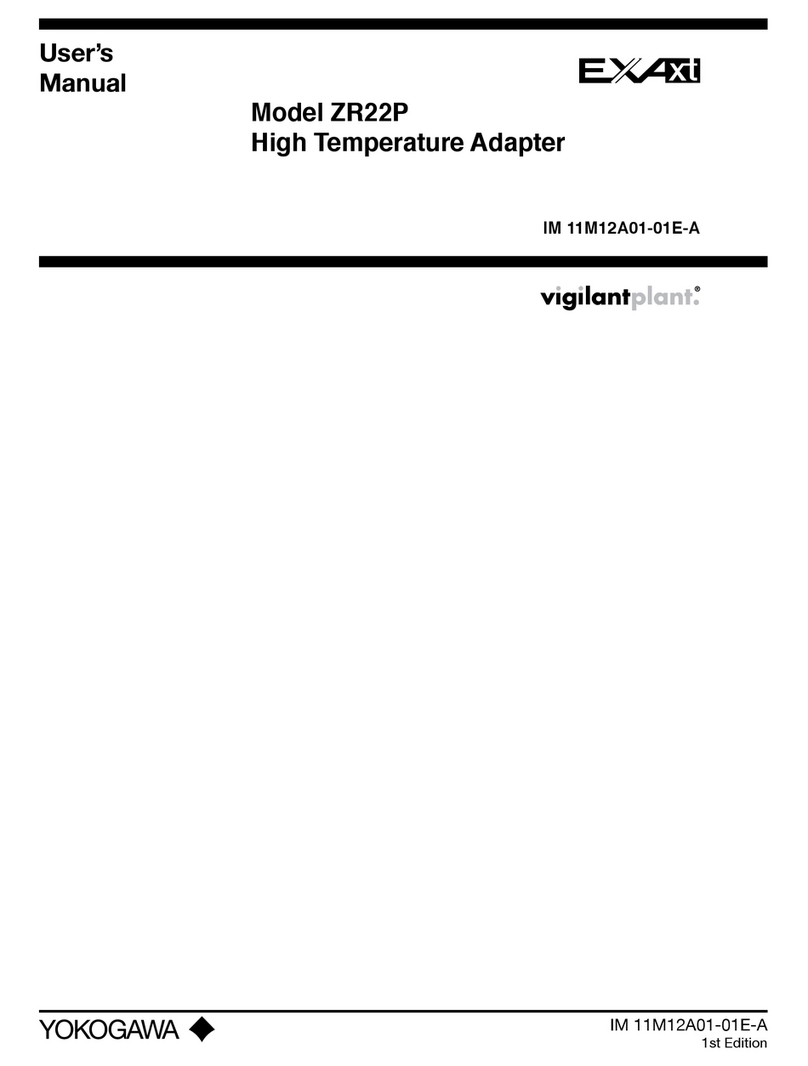
YOKOGAWA
YOKOGAWA ZR22P User manual
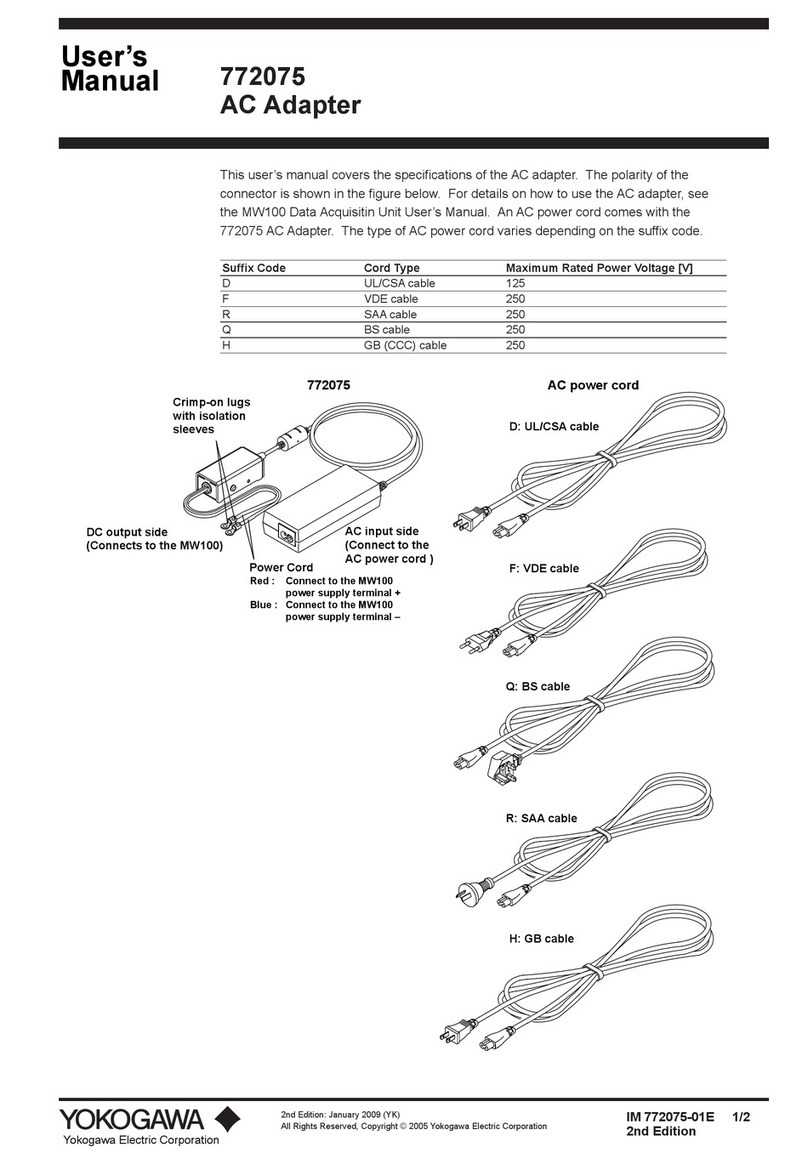
YOKOGAWA
YOKOGAWA 772075 User manual
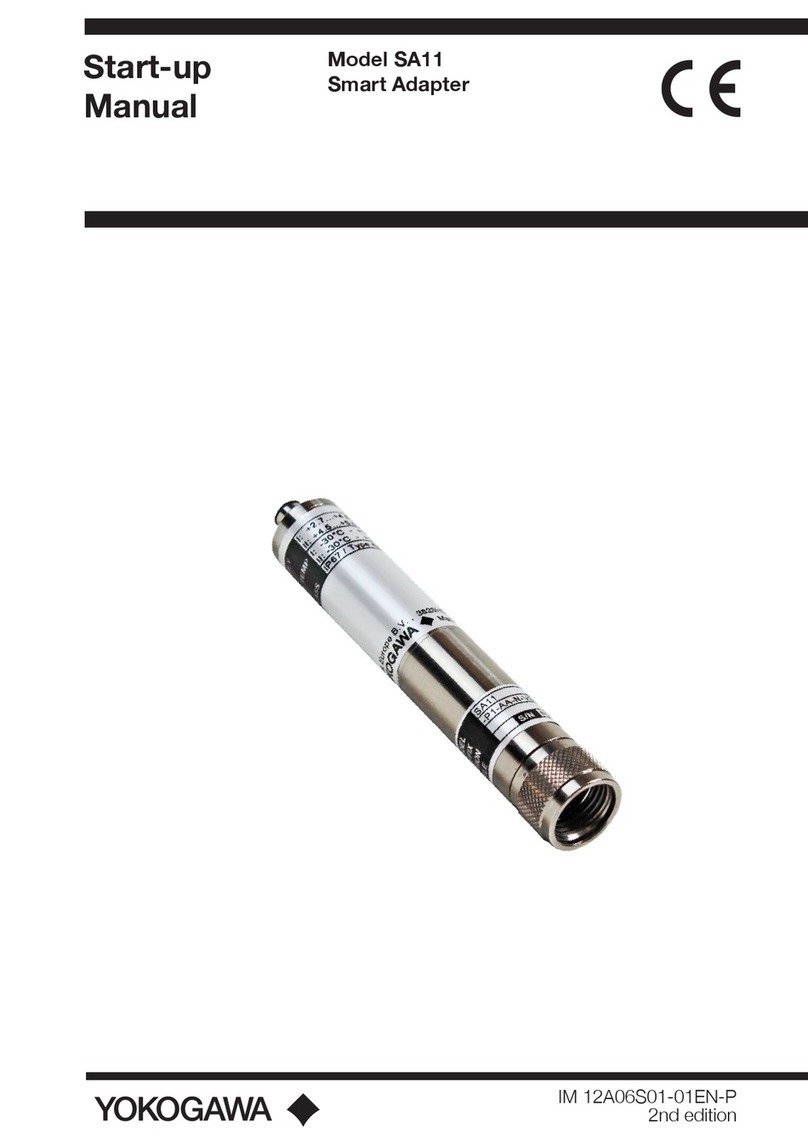
YOKOGAWA
YOKOGAWA SA11 Installation and operation manual
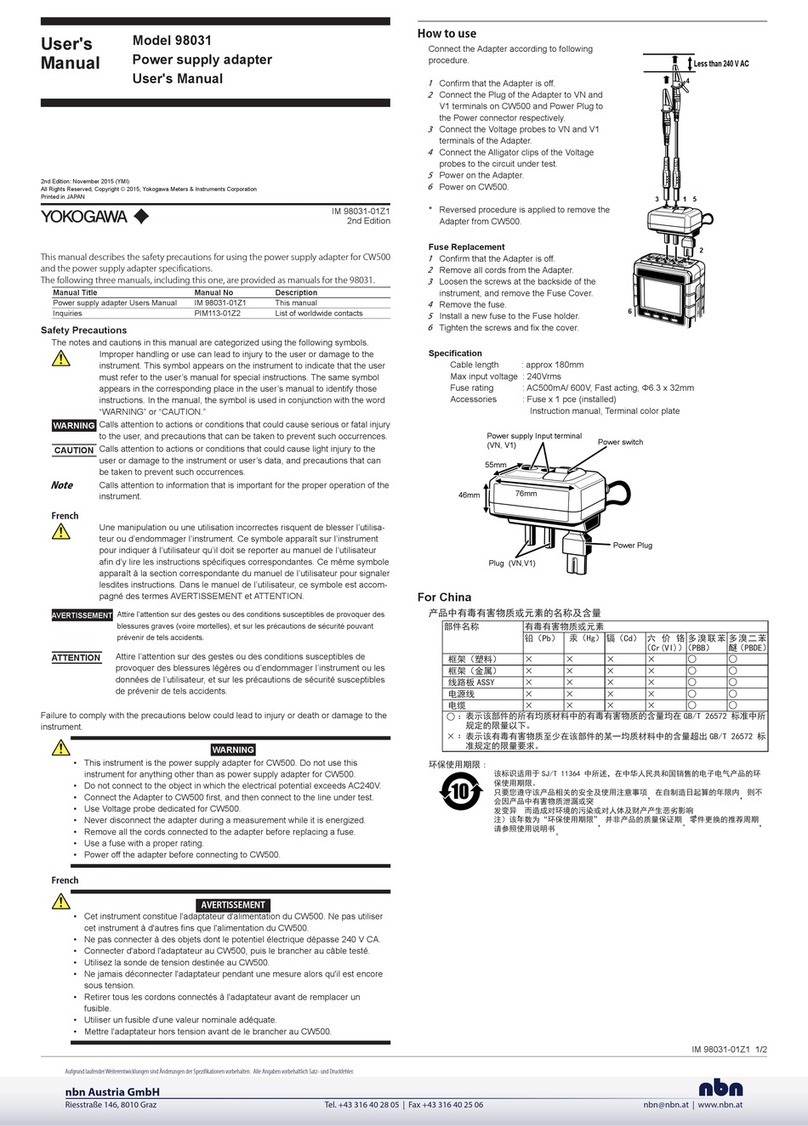
YOKOGAWA
YOKOGAWA 98031 User manual
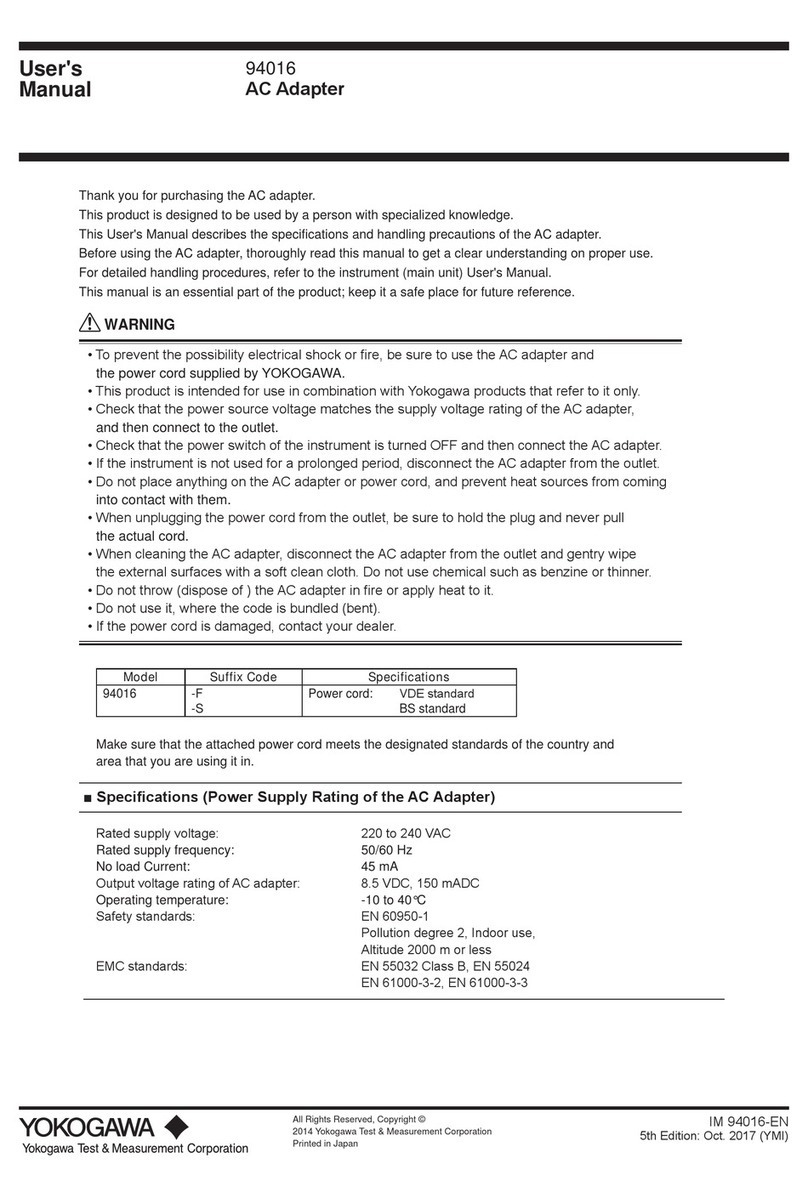
YOKOGAWA
YOKOGAWA 94016 Series User manual

YOKOGAWA
YOKOGAWA 761953 User manual
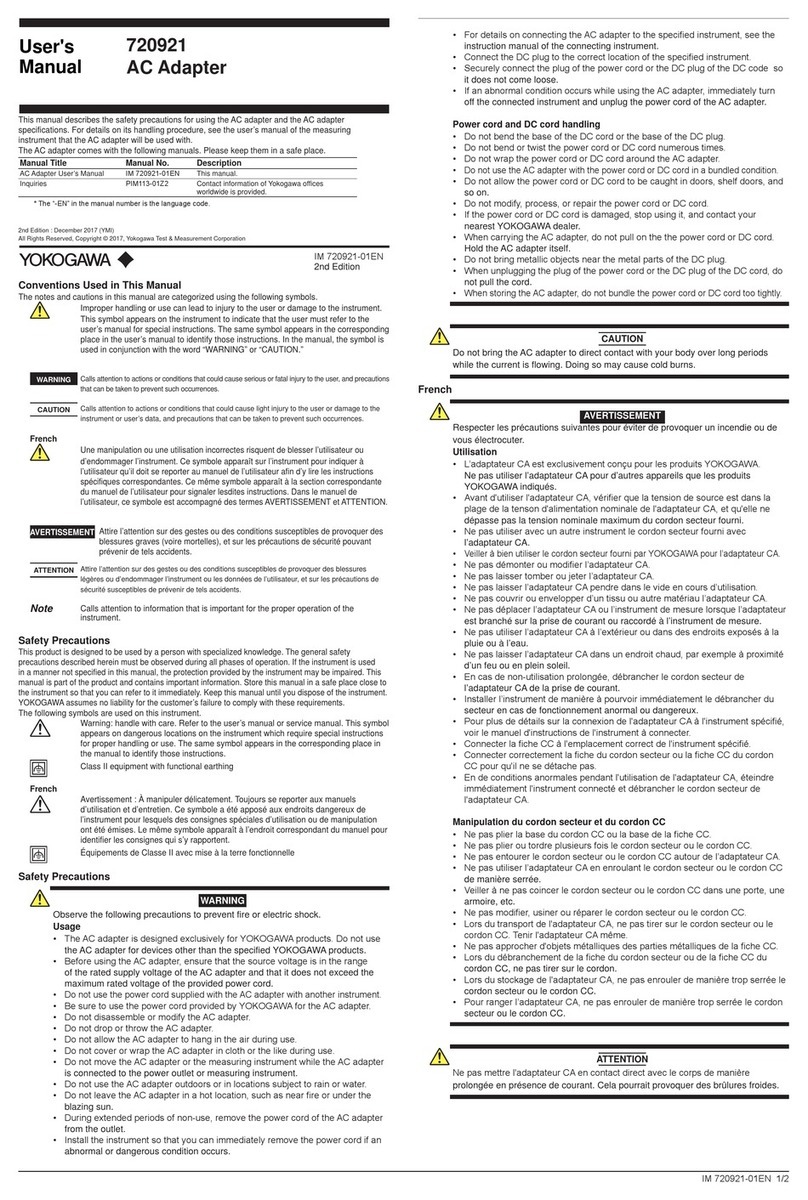
YOKOGAWA
YOKOGAWA 720921 User manual
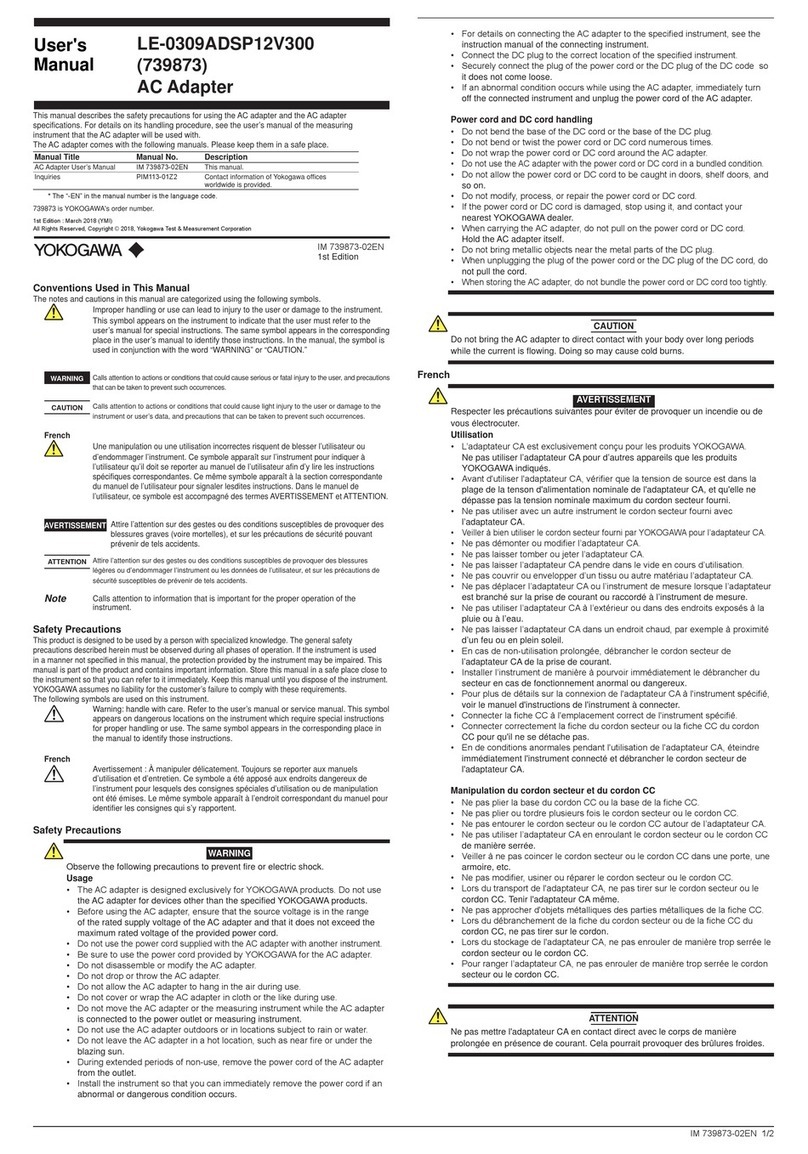
YOKOGAWA
YOKOGAWA LE-0309ADSP12V300 User manual
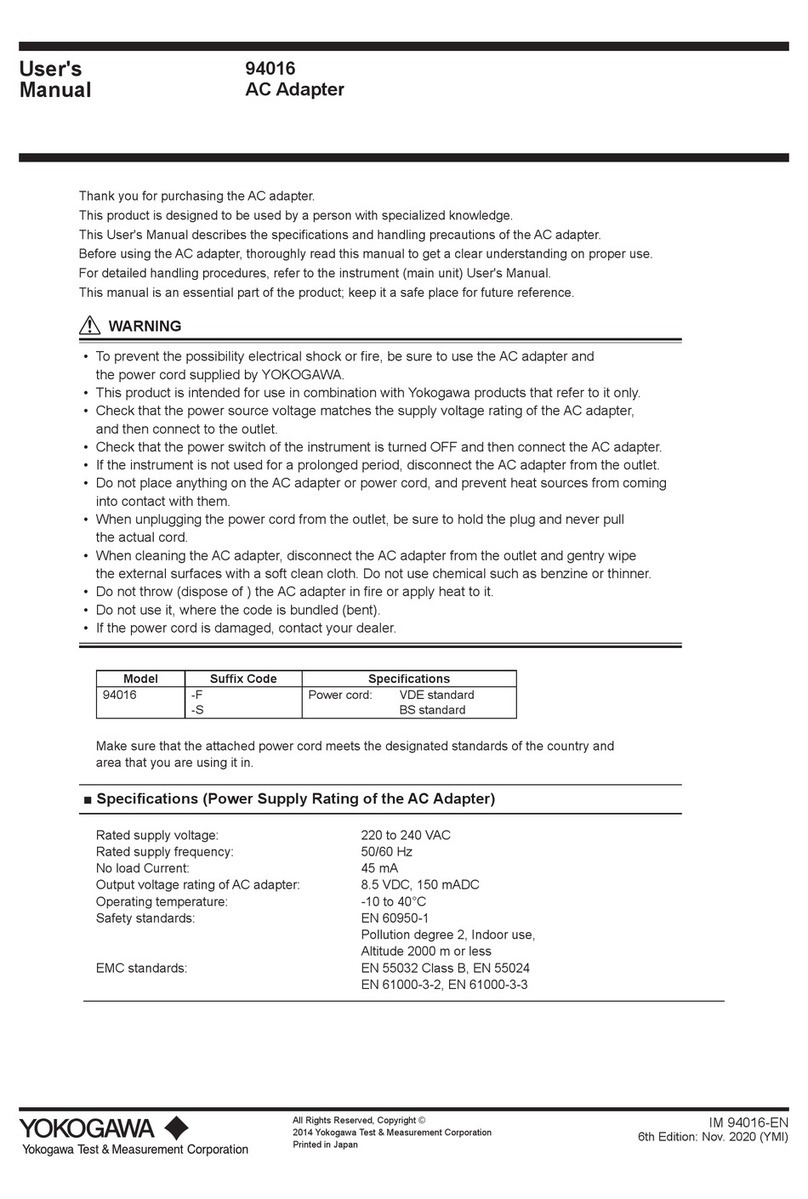
YOKOGAWA
YOKOGAWA 94016 User manual
